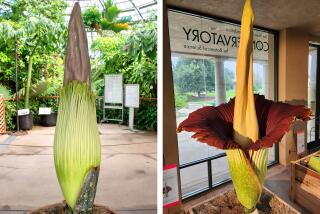Plumeria Send People on Scent-imental Journeys
- Share via
The heady scent of plumeria will send you on vacation every time you smell them.
“Plumeria seem to have a magical hold on people,” says “Jungle” Julie Hunt, a San Clemente landscape consultant and certified arborist who grows and sells a variety of plumeria. “When people smell my plumeria, they get all glassy-eyed and happy and start reminiscing about past vacations.”
Though plumeria are often associated with the Hawaiian Islands and leis, the plant is native to Mexico and India.
Grown as a shrub or small tree, plumeria come in many colors and scents. The flowers can be found in white, pink, red, yellow, gold, peach, apricot, red and violet. Scents include coconut, mango, peach, cinnamon, raspberry, lemon and vanilla.
Plumeria usually bloom from spring to fall here, most going deciduous and dropping their leaves in midwinter.
Now is a good time to find plumeria in bloom and plant them. Some good varieties for this area include ‘Guillot’s Sunset,’ which has long-lasting rainbow-colored flowers, from red to pink, with a vivid orange center. ‘Samoan Fluff’ has large, soft white heavily scented petals. ‘Mokey Man’ is a very fragrant yellow flower.
Other varieties include Dwarf Deciduous, a compact grower with white flowers that have a yellow center. Marino’s Rainbow has large multicolored flowers in yellow, red and pink that have a distinct peach fragrance; Aztec Gold has a large buttercup-yellow flower with white-pink edging and also smells of peaches.
Though they are tropical plants, plumeria are easy to grow, as long as you have a variety that is well-suited to our area, says Hunt, who offers the following growing suggestions:
* Plumeria like a sunny, warm location with protection from hot afternoon sun in inland areas. They also require excellent drainage. If ground drainage is poor, plumeria can be grown in large containers.
* You’ll find plumeria already potted or as cuttings.
To plant already potted plumeria in the ground, choose a high spot and loosen the soil, amending by 50% with an organic mulch or planting mix. Insert a stake in the ground and set the plant next to the stake on top of the soil.
Mound soil around the roots, tamping it well with your hands. Then attach the plumeria to the stake and water lightly. You can also sprinkle alyssum seeds at the plant base. The flowers will help knit the mound when they grow.
Follow the same procedure when planting in a pot. For soil, use a cactus mix, or create soil by mixing three parts high-quality potting soil, one part peat moss, one part perlite and one part sand. Pre-moisten the potting soil and don’t water for a couple of days after planting.
When purchasing a cutting, ask the salesperson if it has been dried. If this hasn’t been done, put the cutting in a bright, arid location for one to two weeks until the end is dried. Then place the end in water and shake off excess, next dipping the cutting in a rooting hormone and slipping it into a container of damp perlite to about an inch.
Place in a location with bright light, watering only once or twice a week when the perlite dries out. In two weeks to a month, the cutting should root, and you can repot or plant it in the ground, as described above.
* Plumeria are susceptible to rotting and should not be allowed to sit in soggy soil. In the summer months when a plumeria is in active growth, it may want a drink every day, but during cooler months, it will require much less. Don’t water during dormancy.
* Feed plumeria a well-balanced fertilizer that contains micronutrients once a month during the growing season.
* Watch for pests--including giant whitefly, thrips and spider mites--which can be treated with ultra-fine horticultural oil spray. Help prevent these pests by washing the plant off with a hard stream of water once a week.
* If you know someone who has a plumeria, you can take cuttings and root them yourself. The best time to take cuttings is in the early spring when the plant is just coming out of dormancy. When doing so, make sure you don’t leave a horizontal wound on the mother plant because it could fill up with water and rot.
* Harvest flowers by bending them at an angle and snapping them off. Place them in water immediately after picking, which will help them seal up quickly.
*
A meeting on plumeria and a sale of unusual cuttings will be held at 2 p.m. July 19 at the South Coast Botanical Gardens, 26300 Crenshaw Blvd., Rolling Hills Estates. The meeting is free; $5 for admission to the garden. (310) 544-6815.
Stokes Tropicals, a mail-order tropical-plant company based in New Iberia, La., carries a variety of plumeria. Call (800) 624-9706 Or visit its Web site at https://www.stokestropicals.com






